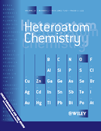Studies on pyrazine derivatives LII: Antibacterial and antifungal activity of nitrogen heterocyclic compounds obtained by pyrazinamidrazone usage
Abstract
Using reactivity of pyrazinamidrazones and their N′-substituted derivatives 1–8 in reaction with sulfonyl chlorides sulfone derivatives 9–17 were obtained, with orthoformate cyclized to sulfonyl compounds 18–20. Amidrazones in reaction with pyraziniminoesters gave dihydrazidines 21–23, which cyclized to 3,5-dipyrazine derivatives of 1,2,4-triazole 24–26. 1-Methyl- or 1-phenyl-3-pyrazine-1,2,4-triazole 27–38 was formed in reaction of amidrazones 1–8 with orthoformate and orthoacetate or benzoyl chloride. N′-Phenylamidrazones 3, 8 in reaction with thionyl chloride were transformed to 1,2,3,5-thiatriazole S-oxides 39, 40. Obtained compounds exhibited low antibacterial activity. Antifungal activity was affirmed for compounds 1, 3, 4, 5, 8, 37, 39, and 40, for which minimal inhibitory concentration (MIC) was in the concentration range of 16–128 μg/mL. © 2011 Wiley Periodicals, Inc. Heteroatom Chem 23:49–58, 2012; View this article online at wileyonlinelibrary.com. DOI 10.1002/hc.20751




